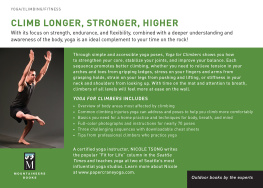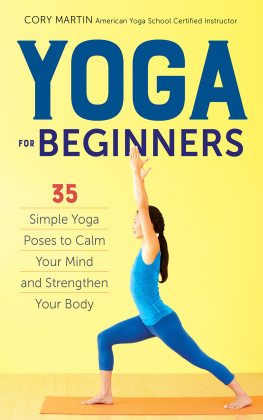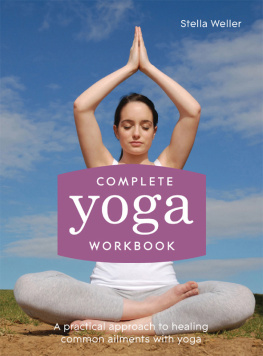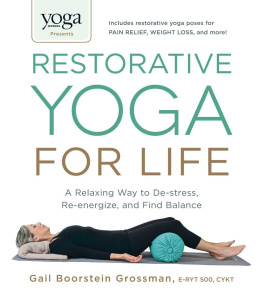 Praise for Being Healthy with Yin Yoga
Praise for Being Healthy with Yin YogaOnce again, Stefanie Arend brings her wisdom to the practice of Yin Yoga. The skill in which she compassionately guides students toward the depth of their uniqueness is a reflection of her many years of dedicated practice and study.
TRACEE STANLEY, owner of Pranamaya Yoga Media
Stefanies book is a wonderful, non-reductive manual and map of the Chinese energetic system and how Yin Yoga can support health and thriving. It will help guide you to a deeper understanding of your own inner terrain, whereupon your own wisdom will then serve as your reliable guide.
JOSH SUMMERS, Yin Yoga and meditation teacher and trainer
and host of the Everyday Sublime podcast
I am so appreciative of Stefanie's well-thought sequences for different health conditions. Finally, an easy, go-to book for the layman who seeks to practice in the comfort of the home without being led by a teacher in class. This book outlines the purpose of each pose alongside easy-to-follow illustrations.
JO PHEE, Assistant to Paul Grilley and Senior Yin Yoga Teacher Trainer
Stefanie Arend has created a comprehensive and inspiring guide for yoga teachers and practitioners alike. In these pages, she offers us the fruit of her years of study and practice, combined with her own personal perspective; this book is a brilliant merger of traditional wisdom with contemporary approach and insight. She is making a real offering to the yoga community, providing practical tools and inspiration for the path that embraces yoga and energetics in an accessible and easy way to understand. It is a pleasure to have all of this information in one place.
SEBASTIAN & MURIELLE PUCELLE, Assistants to Paul Grilley and
Senior Yin Yoga Teacher Trainers
Stefanies work is remarkable for many reasons: it showcases a solid and widespread knowledge of Yin Yoga, fascia, Traditional Chinese Medicine, and much more. It reveals deep wisdom on how to weave this knowledge with sensitivity and compassion to help us recover and heal. More than anything, it applies this wisdom to offer practical, nourishing, and regenerating practices accessible to everyone. I am sure this book can sustain and help many through their self-healing processes. Impressive.
ANAT GEIGER, Assistant to Paul Grilley and Senior Yin Yoga Teacher Trainer
Stefanie Arend
Be Healthy with
Yin Yoga



I dedicate this book to all those who put their trust in their capacity for self-healing and who wish to achieve long-term health.
You carry your healing powers within you at all times, but sometimes they are hidden by a lack of contact with your inner self. A doctor, therapist, or teacher can support you in accessing them once againbut they can only open the dooryou always have to pass through it yourself!

Copyright 2019 by Stefanie Arend
All rights reserved. No part of this publication may be reproduced, distributed, or transmitted in any form or by any means, including photocopying, recording, digital scanning, or other electronic or mechanical methods, without the prior written permission of the publisher, except in the case of brief quotations embodied in critical reviews and certain other noncommercial uses permitted by copyright law. For permission requests, please address She Writes Press.
Published August 2019
Printed in the United States of America
Print ISBN: 978-1-63152-590-2
E-ISBN: 978-1-63152-591-9
Library of Congress Control Number: 2019938513
For information, address:
She Writes Press
1569 Solano Ave #546
Berkeley, CA 94707
Interior formatting by Tabitha Lahr
Photography by Forster & Martin Fotografie, Munich
She Writes Press is a division of SparkPoint Studio, LLC.
This book is not intended as a substitute for the medical advice of physicians. The reader should regularly consult a physician in matters relating to his/her health and particularly with respect to any symptoms that may require diagnosis or medical attention. Neither the author nor the publisher are responsible for any injuries which may result from the practice of the exercises in this book.

Contents

Foreword by
Paul GrilleyWho needs theories?
Running makes us feel good, weight lifting makes us feel good, cycling makes us feel good, and hatha yoga makes us feel good. All of these forms of exercise make us feel good, and most of us dont need a chemical or physiological explanation of how that happens. But a theory of yoga can make a difference in how we practice and what we experience. Yoga has an external aspect that makes it similar to other forms of exercise, but yoga also has an internal aspect that leads us to emotional and mental insights.
The connecting thread from external to internal, from Yang to Yin, is the movement of energy in our body. Focusing on how this energy moves draws our awareness inward. Having a theory of how this happens is very helpful. This theory is provided in the textbooks of Chinese medicine, particularly acupuncture theory. There are two foundational theories of acupuncture. First, there is a life force called Chi. Second, this life force circulates through channels called meridians.
Chi is called a life force because it intelligently adapts the activities of the bodys cells to resist disruptive forces that are constantly striving to create imbalance and illness. Without Chi, our bodies would decompose into a putrid pool of chemicals, which is what happens at death. Chi circulates through meridians that have been described in greater and sometimes lesser detail since ancient times. One of the modern objections to acupuncture in general and meridians in particular is that dissections have never found the meridians that are illustrated in acupuncture textbooks. This is why the modern theories of fascia are important.
Fascia physiology makes it plausible that meridians are electrically conductive channels of water in our fascia. This fascia/meridian theory has been demonstrated in several experiments by my own teacher, Dr. Hirioshi Motoyama. This fascia/meridian theory makes it perfectly clear why hatha yoga developed as a unique system of stretching and joint manipulation. Stretching and joint manipulation stimulates the fascia and, therefore, the flow of Chi through the meridians.
The more difficult scientific hurdle is establishing the existence of Chi. Does Chi exist? How is it different from chemical or electrical energy? This is not the place for a long discussion of the evidence, but we can use it as a jumping-off point to a discussion of objective and subjective experience.
Materialists assert that our emotions and thoughts are only electrical/chemical reactions in the brain. This is the great divide: science can only objectively study electrical/chemical reactions, but we never






 Praise for Being Healthy with Yin Yoga
Praise for Being Healthy with Yin Yoga


